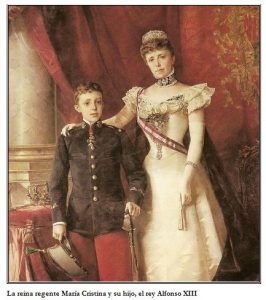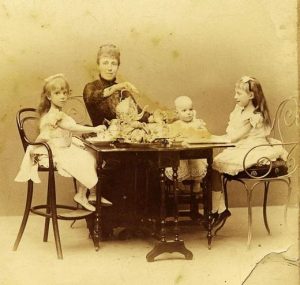Source: “Historia del Palacio de la Isla de Burgos (1883-12010)” de Isaac Rilova Pérez
On November 25, 1885, King Alfonso XII died. His son, Alfonso XIII, who was born in Madrid on May 17, 1886, was too young to govern, so between 1885 and 1902, his mother was the regent queen, until he was sixteen years old.

On May 31, 1906, Alfonso XIII married the British Princess Victoria Eugenia of Battenberg (1887-1969), daughter of Prince Henry of Battenberg and Princess Beatrix of the United Kingdom. He tried to regenerate the country after the disaster of 1998, which meant the loss of the last Spanish colonies (Cuba, Puerto Rico and the Philippines). He also had to face various problems such as the war in Morocco, the workers’ movement and Basque and Catalan nationalism.
During the First World War, Spain remained neutral, favouring the opening up of markets and economic growth, but also provoking certain social upheaval, such as the 1917 crisis alongside Catalan nationalism, military trade unionism and revolutionary strikes. Post-World War II economic readjustment, military failures in Morocco, social unrest and regional problems increased the internal difficulties and weakness of governments.
As a solution, the military man Primo de Rivera, with the king’s support, led a ‘coup d’état’ in 1923, establishing a dictatorship that won certain victories: the war in Morocco ended, social order was restored and public works were developed.
However, in 1930 the king tried to restore constitutional order, but the municipal elections of April 12, led to the proclamation of the Second Republic. The king was forced into exile in Rome, where he lived for 10 years, and where he died on 28 February 1941.
The king visited several Spanish provinces during his reign. Among the provinces to which he travelled, the visit to Burgos on 23rd September 1891, on the occasion of the terrible railway accident between Burgos and Quintanilleja stations, stands out.

The magnitude of the tragedy was such that the queen regent, María Cristina, the king, still young to reign, Alfonso XIII and the Infantas María de las Mercedes and María Teresa, went to Burgos to attend a Requiem mass in the cathedral on 13 October 1891 for the victims of the accident.
Previously, the chief inspector of the royal palaces, Count of Sepulveda, accompanied by the commissions appointed for the purpose of preparing the necessary accommodation for their Majesties and Highnesses, visited certain public buildings where the royal family could stay, without finding any that would be suitable.
Therefore, Santiago de Liniers and Juan Muguiro placed the “Palacio de la Isla” at the disposal of the Count of Sepulveda. After visiting him with Francisca Muguiro, the Count was completely satisfied and the Palace was chosen as his royal residence during his stay in Burgos, while the Muguiro family themselves moved to the hotel of their relatives, the Counts of Liniers. This stay was an immense honor for the Muguiro family, and was embodied in a tombstone at the entrance of the building.